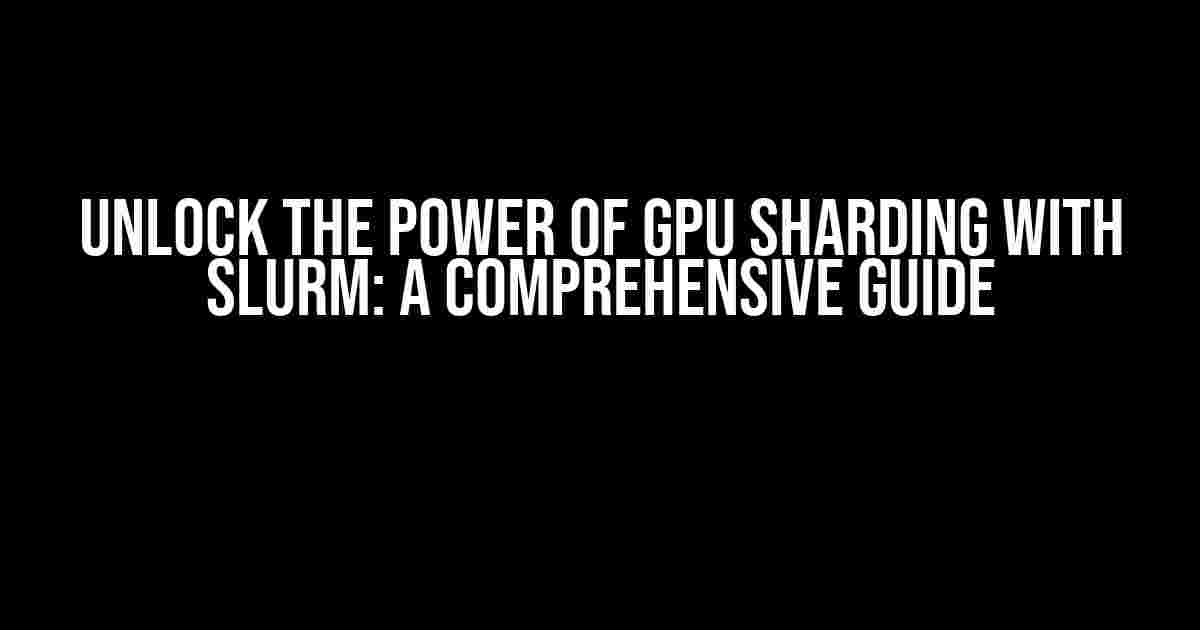Are you tired of waiting for your compute-intensive tasks to finish? Do you want to harness the full potential of your GPU cluster? Look no further! In this article, we’ll dive into the world of Slurm, a powerful open-source workload manager that enables GPU sharding, a game-changing technology that allows you to parallelize your computations across multiple GPUs. By the end of this guide, you’ll be equipped with the knowledge to turbocharge your workflows and take your high-performance computing to the next level.
What is Slurm?
Slurm (Simple Linux Utility for Resource Management) is an open-source workload manager designed to handle the complexities of managing compute resources, including GPUs, CPUs, and memory. It provides a robust and flexible framework for job scheduling, resource allocation, and fault tolerance. With Slurm, you can efficiently manage your cluster resources, optimize job performance, and reduce administrative overhead.
GPU Sharding: The Game-Changer
GPU sharding is a technique that allows you to split a single compute task into smaller, independent chunks and execute them concurrently across multiple GPUs. This approach unlocks unprecedented levels of parallelism, scaling, and performance. By leveraging Slurm’s support for GPU sharding, you can:
- Accelerate compute-intensive tasks, such as machine learning, scientific simulations, and data analytics
- Maximize GPU utilization, reducing idle time and increasing overall throughput
- Scale your workloads to meet the demands of large-scale data processing and high-performance computing
- Improve system reliability and fault tolerance through redundant task execution
How to Set Up Slurm for GPU Sharding
To get started with Slurm and GPU sharding, follow these step-by-step instructions:
-
Install Slurm on your cluster nodes:
sudo apt-get install slurm-wlm -
Configure Slurm to recognize your GPUs:
# slurm.conf GresTypes= gpu Gres=gpu[:gpu_id] -
Define a GPU-enabled partition:
# slurm.conf PartitionName=gpu PartitionState=UP AllowGroups=ALL AllowQoS=ALL SelectType=CONS_TRES -
Create a Slurm job script:
# job.sh #SBATCH --partition=gpu #SBATCH --gres=gpu:2 #SBATCH --ntasks=4 #SBATCH --cpus-per-task=2 #SBATCH --output=results_%j.txt module load cuda ./my_executable
Optimizing Slurm for GPU Sharding
To get the most out of Slurm and GPU sharding, consider the following optimization strategies:
| Optimization Technique | Description |
|---|---|
| GPU Affinity | Bind tasks to specific GPUs using Slurm’s --gres option to minimize data transfer and optimize memory access. |
| GPU-aware Scheduling | Use Slurm’s --sched option to prioritize tasks based on GPU availability and utilization. |
| Data Staging | Pre-fetch data before executing tasks to reduce I/O overhead and optimize memory access. |
| Job Packing | Co-locate tasks with similar resource requirements to minimize idle time and optimize resource utilization. |
Real-World Applications of Slurm and GPU Sharding
Slurm and GPU sharding have far-reaching implications for various industries and domains, including:
-
Machine Learning and AI:
- Accelerate model training and inference for computer vision, natural language processing, and recommender systems
-
Scientific Simulations:
- Speed up simulations for climate modeling, molecular dynamics, and materials science
-
Data Analytics:
- Process large datasets for data mining, business intelligence, and predictive analytics
-
High-Performance Computing:
- Optimize workflows for weather forecasting, fluid dynamics, and computational chemistry
Conclusion
In this article, we’ve explored the exciting world of Slurm and GPU sharding, a powerful combination that unlocks unprecedented levels of parallelism and performance. By following the instructions and optimization strategies outlined above, you’ll be well on your way to harnessing the full potential of your GPU cluster and accelerating your compute-intensive workloads. Remember, with Slurm and GPU sharding, the only limit is your imagination!
Stay tuned for more articles on high-performance computing and Slurm best practices. Happy computing!
Here are 5 Questions and Answers about “Slurm: using GPU sharding” in HTML format:
Frequently Asked Questions
Get answers to the most frequently asked questions about Slurm and GPU sharding.
What is Slurm and how does it utilize GPU sharding?
Slurm is an open-source cluster management and job scheduling system that efficiently utilizes GPU sharding to accelerate compute-intensive workloads. By dividing a single GPU into multiple smaller, independent shards, Slurm enables multiple jobs to share the same GPU, maximizing resource utilization and reducing idle times.
How does Slurm’s GPU sharding benefit my workflow?
Slurm’s GPU sharding technology allows you to make the most of your GPU resources, increasing overall system throughput and reducing job wait times. This means you can process more data, train models faster, and accelerate your research or development projects.
Is Slurm compatible with popular deep learning frameworks?
Yes, Slurm is fully compatible with popular deep learning frameworks like TensorFlow, PyTorch, and MXNet. This means you can seamlessly integrate Slurm into your existing workflow, leveraging the power of GPU sharding to accelerate your deep learning workloads.
Can I use Slurm with multiple GPU architectures?
Absolutely! Slurm supports a wide range of GPU architectures, including NVIDIA, AMD, and Intel. This flexibility allows you to mix and match different GPU types to meet the unique needs of your workloads, ensuring optimal performance and resource utilization.
Is Slurm’s GPU sharding technology scalable for large-scale deployments?
Yes, Slurm’s GPU sharding technology is designed to scale seamlessly for large-scale deployments. Whether you’re working with a small cluster or a massive datacenter, Slurm’s distributed architecture and intelligent resource management ensure that your GPU resources are utilized efficiently, even in the most demanding environments.
